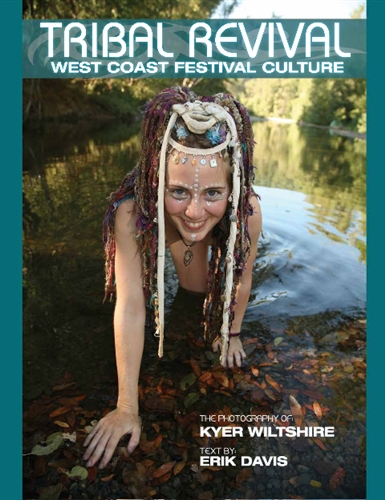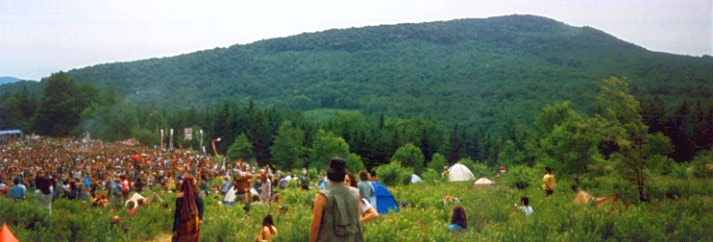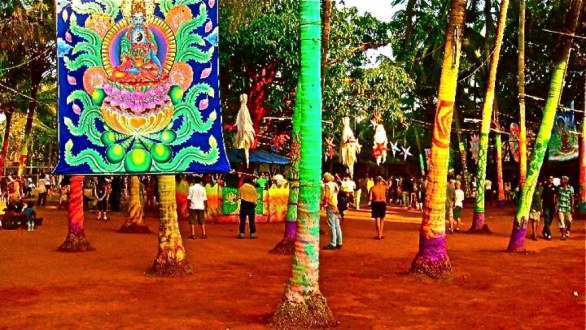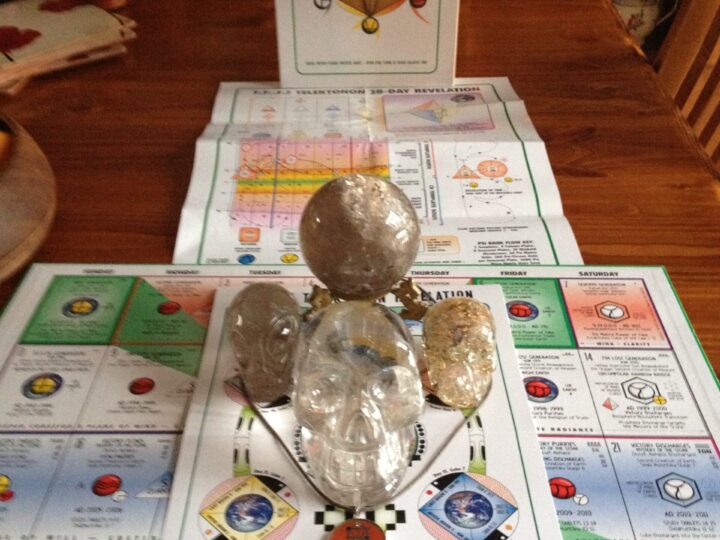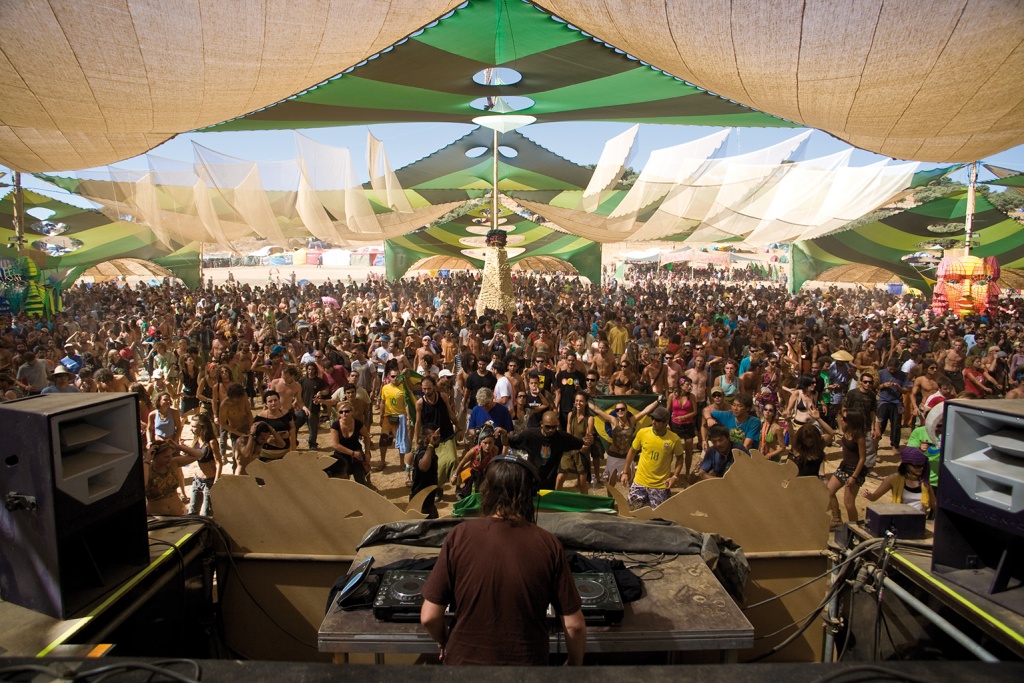
The Analog Life, Arthur issue 31
Idanha-a-Nova, Portugal—This August, around 25,000 people hauled their kit and caboodle down a long hot narrow road in the middle of the Portuguese nowhere to camp like migrants along the shores of a lake not far from the border with Spain. They made the trek to attend Boom, a biannual electronic dance music festival that has grown into a large and successful event that eschews corporate sponsorship and keeps its roots in the underground alive. All sorts attend, but the dominant vibe of the weeklong festival is neotribal: a rave-inflected millennial florescence of hippie shit like long hair, fashion exotica, hardcore psychedelia, trance dancing, healing arts, and paganish New Age mysticism with an apocalyptic thrust. There were chai shops and vegan grub and massage centers and drug information booths, plus four music stages that provided everything from cheesy breakbeats to live world fusion to ambient driftworks. But the core genre was psytrance, that intense and sometimes unnervingly trippy form of electronic dance music whose pulverizing, brain-synching and monotonous beats embody a ferocious psychedelic aspiration that makes dancing at Boom as much a ritual as a party.
Trance culture, especially as it is manifested at neotribal gatherings like Boom, is a colorful and potentially prophetic expression of what I am calling the analog life. The analog life is not just about using and appreciating older technologies and media at a time when the digital imperium is invading and recoding so many regions of culture and consciousness. Rather the analog life is an attempt to reframe our experience along analog lines, to question and even subvert the abstract quantification of cyber-reality through both the metaphor and the practice of “analog” approaches to the world—approaches that stress the organic over the programmed, the local over the global, material flows over disembodied calculations, and the fuzzy and happenstance over the efficient and the exact. This broad sense of the analog can be seen as another expression of the “natural,” but that word has been watered down and confused by centuries of romanticism and the recent explosion of green consumerism. Rather than believing that we understand what it means to be truly natural, we need to remember that we always approach nature through analogy—and that analog is, literally, an analogy, a poetic and procedural expression of the natural through human tools and human culture. In other words, the analog—either as a technology (tube amps) or a metaphor (“waves of energy”)—allows us to understand our attraction to the organic world as more than the nostalgic yearning for a pre-technological age. The analog life is a more organic approach to technological culture itself.
I write for Arthur in part because I believe that its devotion to “all ages counterculture” offer keys to the cultivation of the analog life. So too do many aspects of contemporary neotribal culture, at least as I have come to know it through friends and festivals, principally on the West Coast. On the one hand, neotribalism continues many of the older hippie dreams of a more organic, mythic, ecstatic, and community-based life. (The tribalism goes deeper than the Maori tats.) On the other hand, neotribal dance culture is one of the more media-conscious and forward-plunging of any technologically-amplified global underground. Psy-trance is an intensely computer-dependent form of electronic dance music—a shamanic offspring of disco whose digital Dionysianism has none of the romance of analog gear found in other electronic forms. Many of the psychedelic or “visionary” artists who form an important part of the scene—the next generation of the poster artists and light show wizards of yore—work primarily or exclusively with digital tools. The whole logic of the culture is as much a sign of globalism as cell phones in the hinterlands of Bengal. Neotribal trance music festivals like Boom happen all over the world, from Japan to Brazil, from Transylvania to the West Coast, and many of its participants are inveterate world travelers who undoubtedly burn more jetfuel than kids into global genres like hip-hop or death metal. Many earn their keep by trafficking a variety of goods or even—as in the case of the scene’s sometimes remarkably creative fashion designers—using labor in Bali or India to produce clothes sold for a major mark-up on the festival circuit. Behind the scene’s core ideology of shamanic Gaian consciousness exists a 21st-century experience of culture crafting in the age of globalism—of international social networking, file-sharing, hypermediation, and nomadic travel. Trance planet.
**
I first attended Boom in 2002, and I had a fine time dipping back into the traveler trance-music scene I had first encountered in Goa in the mid-90s. I drank chai, smoked spliffs, shimmied in black light, and hung out with twentysomething freak brothers and sisters from around the world. I was particularly impressed with Crystal and Spore, a loose crew of Canadians who organized and ran the workshop tent—dubbed the Liminal Village in later years—where I gave a talk on meditation, psychedelics, and the bardo. Through graphic design, event planning, collaborative workshops, and the minting of new lingo, this busy elf tribe from the BC coast were attempting to nudge the dance scene into a wider and more intentional cyborganic futurescape. They helped me understand the neotribal festival as something much more than a holdover from an earlier stoner era, or as just another subcultural frequency on the radio dial of electronic dance music. Instead, outdoor neotribal festivals like Boom could serve as something more like a seed crystal or an incubator—a Petri dish of possibility where future forms of community and consciousness are explored, designed, and mapped in a resolutely analog environment.
This analog begins with the ground beneath your feet and the dirt between your toes. Boom takes place in a dry and rolling chunk of land that wends its way along the edge of a large lake that offers relief from the blazing sun but whose water quality nonetheless struck me as dodgy enough to avoid. Scores of temporary structures—some simply serviceable, most charming, and quite a few with exotic but humble flare—organize the flows of this landscape, turning the site itself into a visible cartography for an alternate society. The Ambient Forest, a chill-out stage that also served as a big slumber party bed, lay at the crown of a hill, while down the slope rested the Liminal Village, with its art gallery, films, and bamboo temples. The huge main stage, decorated with enormous interdimensional whimsies, thumped 24-7, while the Healing Area lay in a relatively quiet valley away from the speaker stacks. Learning the layout of the site, which was created by a number of independent though coordinated crews, participants instinctively begin to explore and map a cultural ecology. Though the sheer size of Boom meant the site was bursting at the seams, attendees still tasted a possible world simply by exploring and enjoying themselves.
Given its origins in psychedelic culture, whose neoshamanic biophilia and apocalyptic tenor inevitably conjure up our hurting earth, Boom’s possible world is very much a green and sustainable one. As the “greening” of Burning Man and other large gatherings shows, the festival actually presents a wonderful challenge: design and build a temporary architecture of community that allows thousands of people to have meaningful experiences, to encounter new friends and lovers, and to dance their asses off, while at the same time respecting the ethical demand that all of now face to live more lightly and intelligently on the earth. This work is both practical and utopian. Its practical because festivals are very much part of the world of money and media and technology, and greening them allows small sustainable businesses to establish themselves, not only by selling their wares to organizers, vendors, and participants, but by having a supportive environment to show off their visionary innovations to people predisposed to new nature ways. And the work is utopian because it is an expression of desire and fantasy that takes advantage of the nonordinary nature of festival space-time.
Boom’s rhetoric of planetary consciousness was as pervasive as the hash smoke, but to their credit, the organizers attempted to actually manifest the vision. Veggie oil from the previous Boom fueled the generators, while a series of composting poop toilets were constructed, if not always spiffily maintained. This year’s Liminal Village—which exposed attendees to a variety of green memes—was surrounded with a number of permaculture gardens, some of which were protected from the hot sun by gorgeous bamboo shade structures that were inexpensive and quick to create. Indeed, permaculture—a design strategy of organic farming—can be seen as a major metaphor for this scene’s intermingling of organic and technological. As Delvin Solkinson wrote in the festival magazine Pathways (printed on recycled paper, natch), “It is with paradigms like permaculture, with its green technology, organic approach to agriculture, and locally focused strategies for sustainable development, that the new world culture can establish a focus on healthy co-existence and work to produce a revitalized planetary ecology.”
I am not ready to declare all this a “new world culture” yet, and not just because so many of these memes and practices were first seeded in the Sixties and Seventies. In many ways, Boom reflected as many problems as solutions—reminders of how tough it is to achieve even temporary sustainability when the numbers of attendees swell into the five figures. The most visible sign of failure was the ridiculous amount of litter that pervaded the site, created by knuckleheads treating their much-vaunted Gaia as a receptacle for party detritus. And that was not the only sign of the lack of cleanliness. As with a number of previous Booms (and many outdoor festivals), gastro-intestinal bugs were having a field day, and the critters this year were particularly insidious, laying people low for days and forcing hospital trips. The bottom line made its mark as well. While the Boom’s commitment to using recycled materials for the festival structures sounds good on paper, some folks groused that, in practice, the word “eco” sometimes just means “cheap.” In contrast to American underground festivals like the Rainbow Gathering and Burning Man, where a strong degree of self-reliance hold sway amid a largely cash-free economy, consumerism was woven throughout the Boom, with beer, food, clothing, and other goodies on ready display. While festival vending does allow many people to pursue livelihoods outside of the machine, this cash culture unconsciously reinforces the logic of the world outside.
So is the “planetary consciousness” of neotribal gatherings like Boom just window dressing for the same old hedonistic consumption and pursuit of distraction? Perhaps. But as a self-consciously visionary environment, it makes sense that Boom foreshadowed the apocalypse as much as the eco-dream—a gathering of the tribes that sometimes resembled a refugee camp. Even the landscape itself reflected this ambivalence: the highest mountain visible from the festival site is called Monsanto, or Holy Mountain, a name that also conjured up the corporate colonization of the biosphere, not to mention our language and imaginations. And from the peak of Monsanto, where a medieval walled fortress bespeaks the endless machinations of human battle, the dusty parking lots and tent cities and pounding sound systems of the Boom may look less like the leading edge of a Gaian transformation, and more like a postmodern ghost dance, a party at the hot rim of a volcano ready to burst. There are no guarantees, and no one should ever believe that a groove or a vision will save them or the world. That said, the new tribes are cultivating analog values that allow people to wake up to our condition without losing heart, to celebrate with their eyes open to the real situation in the world. As Coldcut’s Matt Black pointed out in a talk he gave at the Liminal Village, perhaps the best justification for these sort of hedonic celebrations is that it lets the planet know that at least some of us are genuinely happy and grateful to be alive, in our bodies, enthralled with the reverberant earth.

